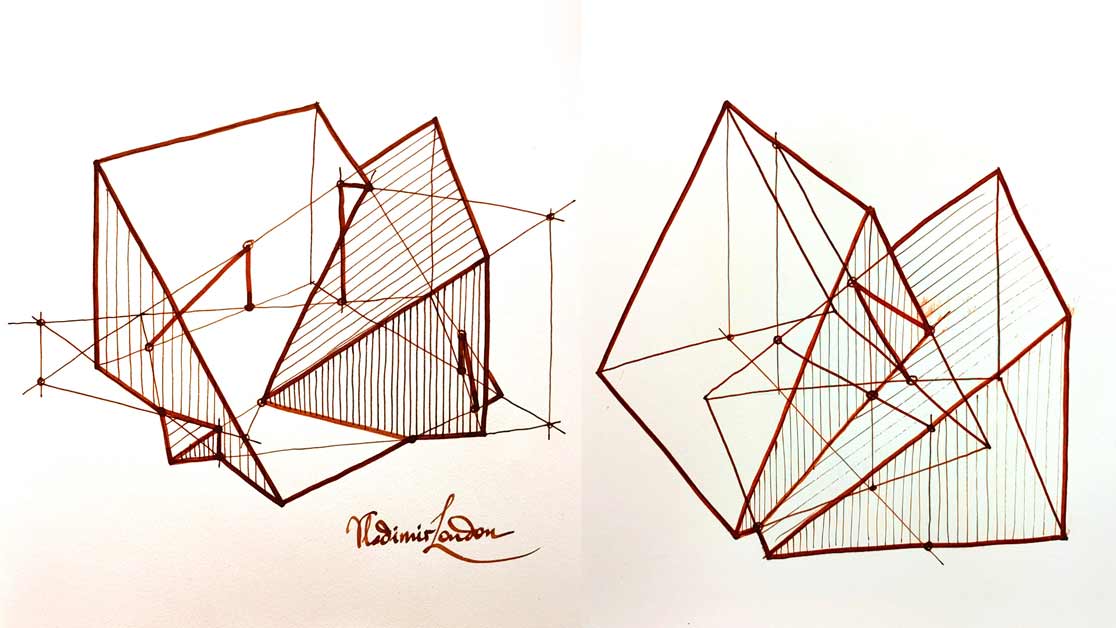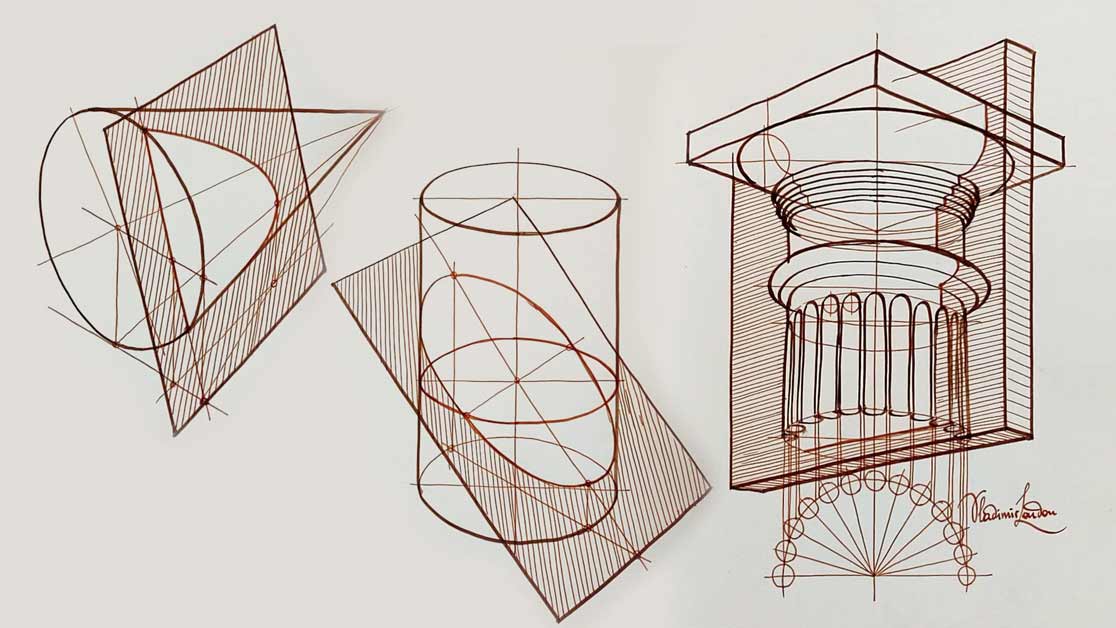How to Intersect Triangular Prisms
Video by Vladimir London
Enroll in the Life Drawing Academy now!
How to Intersect Triangular Prisms

This video was created to help one student to learn one small part of a huge subject of constructive drawing. At the same time, I believe many other viewers will find it inspirational and educational. If you want to get strong drawing skills, consider taking the Life Drawing Academy Correspondence Course. In this course, you will get truly unique one-to-one personal tutoring that is not available anywhere else. Contemporary art colleges simply do not have such a drawing curriculum and you won't find such information in books in English. This is not only the best personal tutoring course available today on the Internet, but also the cheapest way to achieve the advanced level of drawing skills.
In the Life Drawing Academy Correspondence Course, students do various drawing tasks, including how to draw with a pencil the right way, how to use a pencil to measure from life, how to render tonal values, linear and aerial perspective, how to draw contours, how to draw realistic portraits from different points of view, how to draw figures with the full knowledge of anatomy for artists and construction of a human body, how to make figurative compositions, how to depict emotions, and so on. To render tonal values the professional way, an artist must understand the theory of contours. This theory is related to intersecting objects with planes, so some students go deeper in this topic and decide to practice tasks on intersection of geometric solid bodies.
Most man-made and many organic objects you see around you consist of different simple bodies, such as cuboids, cylinders and spheres. Understanding how to draw such objects greatly helps in depicting whatever you see or imagine. This is when using constructive drawing principles becomes very helpful. Intersection of objects is just a small part of such constructive drawing and students who take the Life Drawing Academy personal tutoring course learn a great deal of constructive drawing that is not taught at contemporary art colleges. In fact, I do not know any art institution that teaches in depth fine artists such a constructive approach as intersections and the Life Drawing Academy Correspondence Course is the only place where you can learn all you need to know about this topic. When you know how to intersect objects, it is very easy to draw whatever you like from imagination, like for example, these cylindrical objects, or even cut in half a Doric Order capital as you see here.

To begin with, let's draw two prisms with rectangular footprints. Both these prisms are seen in two-point perspective and have rectangular footprints that partly overlap each other. Each prism will have one tilted plane and three vertical sides. I'm using thin lines to draw all edges and depict these objects as if they are totally transparent. Outlines of two footprints cross each other in eight points. I will circle all these points here. Two foreground vertical edges have a vertical intersection line. Now, let's build the intersection. I will extend two footprints lines. The tilted plane line is extended as well. The vertical virtual line is where extended planes cross each other. Its top point belongs to the tilted plane and now can be connected with another point on that plane. This virtual line crosses the tilted plane edge. It is the important cross-section point. Let's apply the same logic at another end. I extend two planes beyond the prisms. However, this time the geometry is more interesting; it happens below the ground. The cross-point is lower than the footprint. It can be now connected with the key-point on the prism's edge. This virtual line crosses the tilted plane edge in another important cross-point. Two such points on the same tilted plane give us the cross-section line between two tilted planes. I will outline this cross-section line with a bold pen-stroke. The remaining part of this cross-section consists of two lines, which are not visible from this point of view. Nevertheless, I will outline them in bold as well. Another cross-section line connects two points on the vertical side of the prism. The corner of that prism is sticking out. I will draw its cross-section as well. Another corner also protrudes out, but its cross-section line is not visible. I will draw it in bold here. The remaining intersection is at the back of this composition. It is invisible, but I draw it in bold anyway. With all the intersection lines in place, we can now clearly see which edges of prisms are visible. I will outline those edges in bold strokes. Because this ink pen does not change its boldness under different pressure, all bold lines will have the same width. However, if you draw in graphite pencil, it's time to apply the aerial perspective, making those edges that are closer to a viewer bolder and darker and fading away the background lines. I will also hatch tonal values in parallel pen-strokes. Two vertical sides will catch less light and therefore will be darker than top planes. Rendering tonal values is optional in this task.
I will make one more drawing of triangular prisms intersecting each other. Students do such drawings in graphite pencil, which is easy to erase and fix mistakes. I will draw in pen and ink, so every line will be definite and clearly visible. Here's one prism depicted in a two-point perspective. Now, I will draw another prism on the same ground; it intersects the previous one. You can see that footprints cross each other in two points. I will circle these points. Now, I will draw a projection of the top edge to the ground. This line goes through two points and is extended beyond the footprint. From the points where this line crosses the second prism, I draw two vertical lines upward. These lines cross the tilted plane in two points, which can be connected because they belong to the same plane. This virtual line crosses the vertical line depicted earlier. This cross-point belongs to both prisms and can be used to build the first intersection line. I can highlight this line with a thicker stroke. At the top, there is another important point; it can be connected with the point where two footprints cross each other. This line gives us another intersection point, and two points on the same plane can be connected with a thick intersection stroke. The third line that points to the ground completes the intersection. With the intersection lines in place, I can now make visible edges bolder and leave invisible lines as is. There are endless ways to arrange two prisms, so there are many more ways to build their intersections. But I hope that this demonstration was helpful and gives an idea what methods to use when solving such tasks. To make the cross-section more visible, I will now hatch shaded areas.
In the Life Drawing Academy course, students get special exercises to develop their hatching skills and learn rules of good tonal rendering. The Correspondence Course comes with every possible topic you want to learn - from tonal rendering to portrait drawing; from constructive principles to creative compositions. Its curriculum has 100 drawing tasks for students of all levels from complete beginners to advanced artists.
To learn good drawing techniques, enroll in the Life Drawing Academy course:
Online Course
A self-study, self-paced course for you to learn fundamental methods of classical drawing and improve life drawing skills by watching video lessons and doing assignments
- Unlimited access to 52 life drawing video lessons
- Lifetime membership without deadlines
- Unlimited support from the Academy tutors
- Constructive critique of your artworks
- Member access to the Academy's Art community
- Place in the Academy's Students Gallery
- Exclusive members-only newsletter and bonuses
- Life Drawing Academy Diploma of Excellence in your name
One-time payment - Lifetime membership
$297 USD
Personal Tutoring Online + Online Course
The ultimate choice if you who would like to receive personal, one-to-one tutoring from the Academy teachers, which is custom-tailored to your skills and needs
- Everything in Online Course, plus:
- Dedicated team of art tutors
- Assessment of your current level of drawing skills
- Personalized curriculum tailored to your skills and goals
- Up to 100 drawing tasks with by-task assessment
- Unlimited one-to-one personal coaching with detailed per-task instructions and feedback
- Artwork critiques and results-oriented guidance
One-time payment - Lifetime membership
$997 USD




